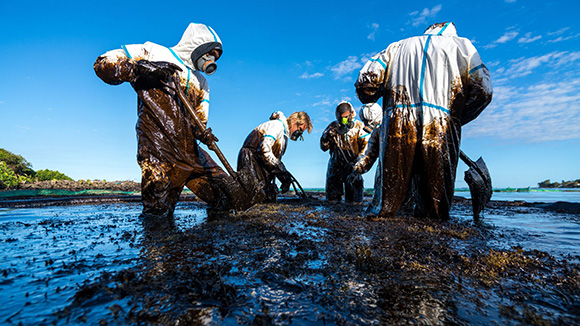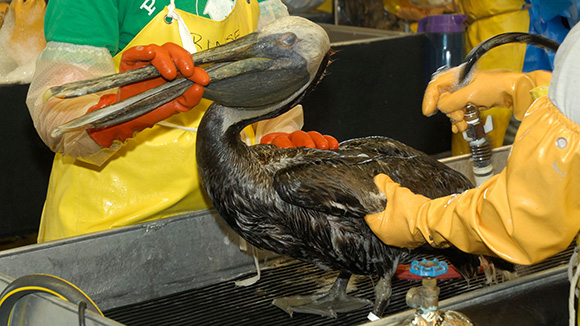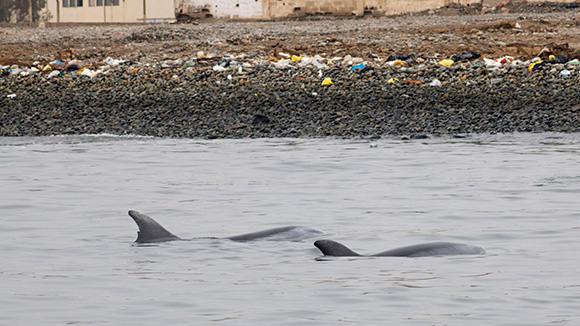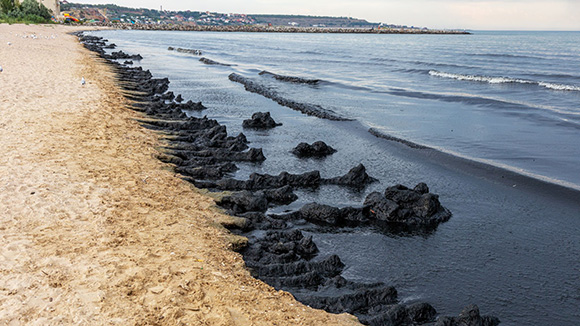Orange County’s coastline is at risk after about 126,000 gallons of crude oil spilled into Southern California’s coastline.

On Monday, Oct. 4, a disastrous oil spill off the coast of Southern California endangered popular beaches. Crews rushed to the scene to contain the widespread crude to protect wetlands. This hazardous leakage caused mayhem, killing wildlife with its damage to our shoreline still unknown. Tar patties continue to wash up along Orange County’s coast, while cleanup crews attempt to scoop out the oil before it causes more harm. This series of events has escalated into numerous lawsuits against Amplify Energy, as their pipeline was at fault for this environmental disaster. Local businesses after experiencing a financial hit from the Coronavirus pandemic are faced with having to temporarily shut down yet again. Workers have managed to clean the oil from the sand near the pier of Newport Beach.
Authorities state that the current estimate of oil ranges from a minimum of 25,000 gallons to 131,000 gallons. The oil leaked from a ruptured underwater pipeline that spilled through a 13-inch slit in the pipeline connected to Platform Elly off the coast of Huntington Beach.
Officials from the U.S. Coast Guard, State Department of Fish and Wildlife, and the company responsible for the damage, Amplified Energy, have worked endlessly to contain the oil spill this past week. The world awaits any type of updates as disaster response authorities have cut off their regular news conferences.
This so-called unified command announced Friday morning that they will no longer make authorities available for public questioning until “new significant information becomes available.” This will, in turn, leave locals in the dark awaiting any type of update, as they continue to struggle with the massive cleanup.

What is Being Done?
Federal authorities have confirmed that a part of Amplify Energy’s oil pipeline was damaged and moved more than 100 feet along the ocean floor. Indicating that the ship’s anchor may have caused the spill. Though the investigation is ongoing, disaster response authorities have disclosed that Amplify Energy and all others liable for the environmental catastrophe will pay for the cleanup and more.
“They are also liable for economic losses experienced by our citizens and by our small businesses,” Assemblywoman Cottie Petrie-Norris said.

Impacts on Wildlife
The deadly effects of petroleum on wildlife have left about two dozen oiled seabirds. They have since been recovered. Wildlife officials do not yet have an estimate of how many birds, fish, marine mammals and other creatures have died in the spill, with five birds being reported dead thus far. Oil recovery crews continue to work the Talbert Marsh in Huntington Beach, preserving important reserves like the Bolsa Chica wetlands and Newport Back Bay.
Coastline College's Professor of Organismal Biology and Marine Science, Dr. Tanya R. Hoerer, PhD states how these estuaries are important nurseries for over 60 species of fish, including sharks, invertebrates and the green sea turtle. They are vital nesting sites for over 200 species of birds, including several endangered species. They are also home to many land mammals and several species of endangered plants. The success of the fish in the nurseries here, influences the abundance of fish populations in our local open ocean.
Our local species of dolphins include the Pacific white sided, short- and long- beaked common dolphin, and the bottlenose dolphin. None of these species are considered endangered or threatened. All marine mammals are protected by our federal laws. (NOAA Fisheries).
How does this affect Coastline Students?
According to Dr. Hoerer, the effects of a small spill can take up to 15 years to completely disappear. Once the oil reaches the coast, its effects are multiplied (Markleen, a major manufacturer of spill response and aquaculture equipment).
This nuisance has impacted the coastline from the Huntington Beach pier all the way south to the Corona del Mar Main Beach, which is over eight miles of the county coastline. The spill has also led to the cancellation of the second day of the Huntington Beach air show. 5,544 gallons of oil, 4% of the spill, has been recovered from the water less than one week after the spill.

What you can do to help with the Environmental Damage
Coastline is looking for volunteers to help clean up the shoreline and those who do will receive a free Coastline water bottle! Also, consider these points and tips from Dr. Hoerer:
What can Coastline students do?
https://owcn.vetmed.ucdavis.edu/